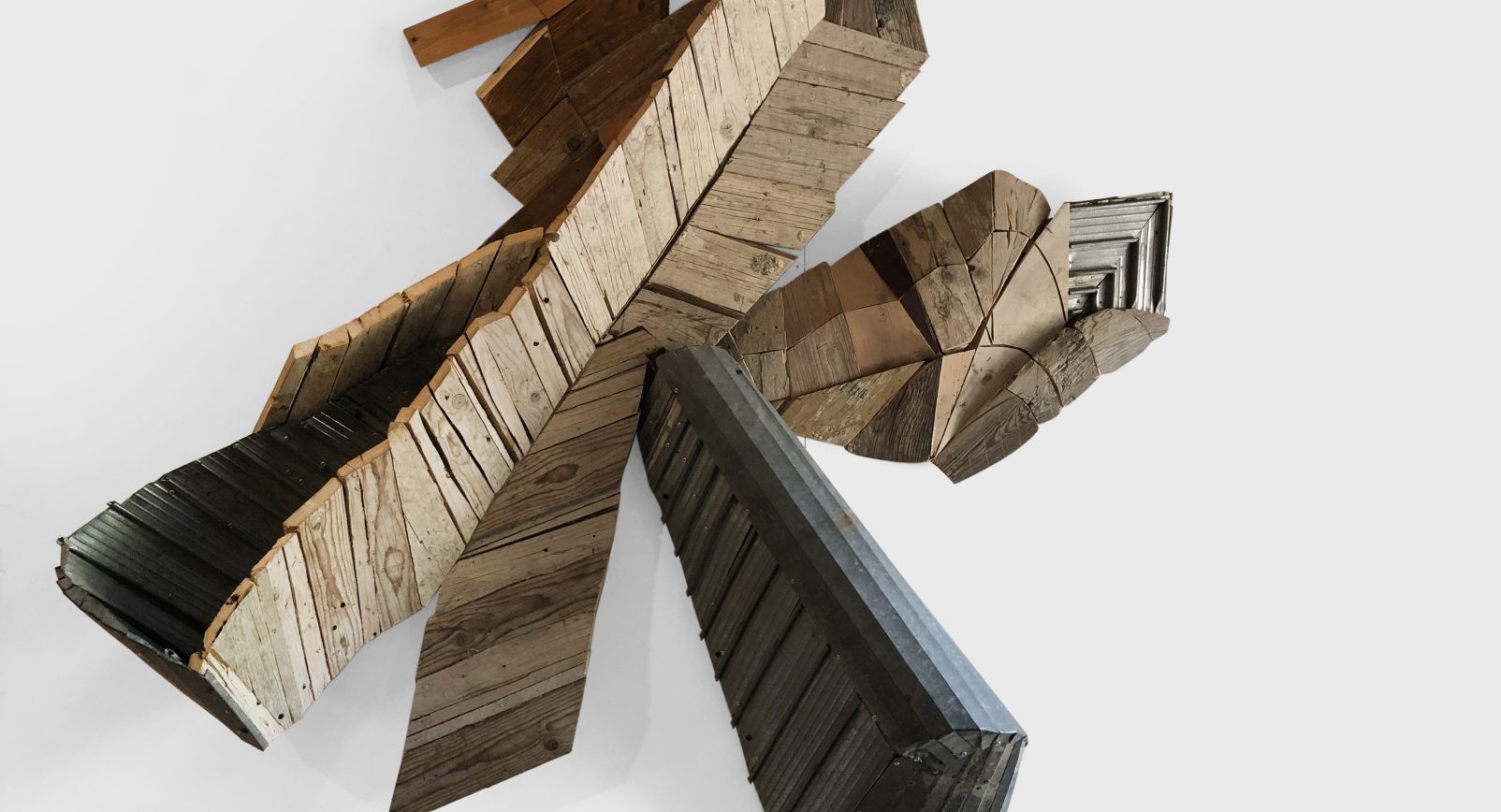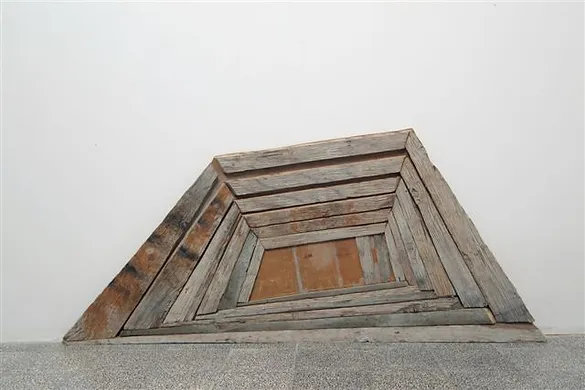
מיטל קילמניק
וג׳האת נד׳ר* | רענן חרל"פ
*תרגום לעברית: נקודות מבט
האמן רענן חרל"פ מצליח להכניס את המרחב העירוני האישי שלו לתוך הגלריה של מרכז אמנויות במעלות-תרשיחא ולבודד אותו בין קירותיה של הקובייה הלבנה.
חרל"פ שגדל בירושלים, התלווה אל אביו בעבודתו כשרברב בניין וספג את אווירת רחובות העיר. בשיטוטיו ברחוב הוא מלקט פיסות עצים ומעניק להן משמעות חדשה. משטחי העץ הזנוחים וחלקי העץ הפזורים ברחוב, הנקשרים באופן אינטואיטיבי לעבודת הכפיים של פועל הבניין, הופכים בין אצבעותיו של חרל"פ לתלת-ממד אסתטי המשמר את החוויות הגולמיות הטמונות בהם.
התערוכה של חרל"פ בשמה הערבי וג׳האת נד׳ר מהדהדת את המושג עבודה ערבית ומעוררת התייחסויות פוליטיות נוקבות. בדומה למורכבות הפוליטית הלוקאלית, שאנו חשים בה במיוחד בזמן הצגת התערוכה.
חרל"פ אינו מעוניין בריקון המשמעות הגולמית של החומר הנטוש אלא להפך, הוא מעוניין באיחוי בין הפיסות. פעולת הגריעה ומתן משמעות חדשה מעצימים את זו הראשונה. שכבות העץ הן ביטוי לשכבות החברה הישראלית הרבודה והעץ הלא מעובד הוא מטאפורה לעור החשוף של אזרחיה. חרל"פ אינו מסתיר את התפרים והאיחויים שהוא עושה. הוא משאיר את החומר בגולמיותו ועורך בו עיבוד גס ועדין גם יחד, כדי להותיר מקום של כבוד לחומר אותו אסף ברחוב.
היצירות בתערוכה מהדהדות את המונח הצרפתי טרומפ-לויל (Trompe-loeil), שמשמעותו להונות את העין. בעבודות התפרצות, סולם, בור והגשר הדגש הוא על הטעיית העין האנושית. ארבע היצירות נעות בין יצירת אשליה של עומק וקירבה לבין שטחיות מרוחקת. העבודה התפרצות, כמו שועטת אל הצופה והבור מאיים לבלוע אותו.
חרל"פ מאפשר קריאה חדשה בתורת הפרספקטיבה שפרחה תקופת הרנסנס האיטלקי. האמן מתייחס ביצירותיו למציאות באופן אובייקטיבי, משוחרר מאי דיוקים של תפיסות סובייקטיביות. הפרספקטיבה של חרל"פ עוסקת בהפשטה שאינה כרוכה בשיטות טכנולוגיות והיא בעלת ערכים של ייצוג מציאות מדומה שלה תכונות חופפות לאלו של המציאות הגשמית.
בסדרת רישומי הדיו מנכיח חרל"פ את ילדותו בשכונת קריית יובל בירושלים. הוא מתאר את הדמויות ואת המשחקים בצורה עלומה כשצבעי המים והדיו מבקשים להתפשט על הדף ומטשטשים את זהותם של האובייקטים והדמויות.
סדרת המצביעים של חרל"פ מתארת ילדים בכיתת לימוד בהשראת צילומים של אמו. פעולת ההצבעה בכיתה של הקולקטיב- היא הסימן הקובע, שיכול להתפרש כסקרנות, שאלה או מענה וגם כמוטיבציה.
כיתת האמן בתערוכה מזמינה את הצופה האינדיבידואלי לזהות את דמותו שלו עם אחד המצביעים של חרל"פ, ולשאול שאלות לגבי השתתפותו או אי השתתפותו בשיעור. מה בלט, סקרנותו או ביישנותו, איזה תלמיד היה ומה נותר מימי לימודיו?
חרל"פ שומר בעבודותיו על מתח מתמיד בין החומר הזמין לבין הפעולות שהאמן עושה בחומר. הוא בודק את גבולות החומר, מאציל עליו את ההיסטוריה האישית שלו אך בד בבד שומר על גולמיותו. בכל יצירה ניתן לחוש את סקרנותו הטבעית ואת טביעת אצבעותיו.
אוצרת: מיטל קילמניק
Wajahat Nadar [Arabic: Points of View]
Ra’anan Harlap
The artist Ra’anan Harlap manages to introduce his own urban space into the Gallery of the Ma’alot-Tarshiha Art Center, and to isolate it within the walls of the white cube.
Harlap grew up in Jerusalem, where he would accompany his plumber father at work and absorb the atmosphere of the city streets. As he wanders the streets, he collects bits of wood and lends them new meaning. In Harlap’s hands, the abandoned wooden planks and the pieces of wood strewn in the street, which intuitively evoke the manual labor of the construction worker, turn into esthetic three-dimensional objects that preserve their inherent rawness.
The Arabic title of Harlap’s exhibition, Wajahat Nadar, echoes the concept of “Arab work” and evokes trenchant political references that allude to the current local political complexity that we are currently experiencing.
Far from seeking to rid the abandoned material of its raw meaning, Harlap strives to fuse the pieces together. The act of reduction and the endowment of new meaning serve to empower the former. The layers of wood express the strata of Israel’s society and the untreated wood is a metaphor for its citizens’ exposed skin. Harlap does not conceal the stitches and the fusions he makes. He preserves the material’s rawness and processes it both roughly and delicately, respecting its integrity.
Harlap’s works echo the French term Trompe-l’oeil, which means to trick the eye. In the works Bursting Forth, Ladder, The Pit, and The Bridge he places the emphasis on deceiving the human eye. These four works oscillate between creating the illusion of depth and proximity and a distant superficiality. Bursting Forth seems to be rushing toward the viewer, while The Pit threatens to engulf them.
Harlap enables a fresh reading of the theory of perspective that flourished during the Italian Renaissance. In his works he approaches reality objectively, free of the inaccuracies that stem from subjective concepts. His perspective deals with abstraction unencumbered by technological methods, suited to the representation of an imagined reality that possesses characteristics which run parallel to those of tangible reality.
In the series Ink Drawings, Harlap addresses his childhood in the Kiryat Yovel neighborhood of Jerusalem. He depicts the figures and the games they played in an obscure manner; the watercolors and ink seem to seek to spread across the page and blur the identity of the objects and the figures.
Harlap’s series titled Raising the Hand, which depicts children in a classroom, was inspired by his mother’s photographs. The act of raising one’s hand in the classroom is the definitive sign, which may be interpreted as curiosity, a question, or an answer, as well as motivation.
The artist’s class at the exhibition invites the individual viewer to identify with one of Harlap’s hand raisers and to ask questions about his or her participation or lack of participation in the lesson. What stood out, curiosity or bashfulness, what kind of student was one and what has remained from one’s schooldays?
In his works Harlap maintains a constant tension between the available material and the way the artist molds it. He examines the limits of the material, and projects onto it his own history while preserving its original state. In each of his works one senses his natural curiosity and his fingerprints.
Curator: Meital Kilemnik







